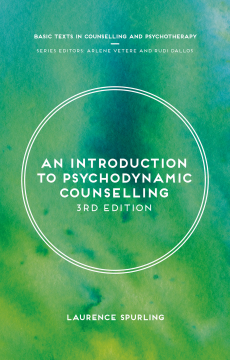
Additional Information
Book Details
Abstract
This engaging and accessible text explores the key assumptions, main theoretical ideas and principles of practice behind psychodynamic counselling. Looking at evidence-based practice, supervision, and the different stages of counselling, this new edition continues to be a valuable text for counsellors and psychotherapists from all disciplines.
Laurence Spurling initially trained as a social worker, and now works as a Senior Lecturer in Counselling at Birkbeck College, University of London, as a Consultant Adult Psychotherapist in the National Health Service, and in private practice as a psychotherapist.
Table of Contents
| Section Title | Page | Action | Price |
|---|---|---|---|
| Cover | Cover | ||
| Contents | v | ||
| Acknowledgements | viii | ||
| Preface to the Third Edition | ix | ||
| Introduction | 1 | ||
| 1 The Basic Principles of Therapeutic Practice and the Concept of Containment | 5 | ||
| The therapeutic in everyday life | 5 | ||
| The roots of the therapeutic in ritual healing | 9 | ||
| From mastery to dialogue | 12 | ||
| Therapeutic dialogue | 13 | ||
| Containment: the basic therapeutic principle | 19 | ||
| Summary | 23 | ||
| Further reading | 24 | ||
| 2 The Setting | 25 | ||
| The setting as the instrument of the container function of the counsellor | 25 | ||
| The features of the setting | 26 | ||
| Spatial aspects of the setting | 27 | ||
| Temporal aspects of the setting | 28 | ||
| Contractual aspects of the setting | 30 | ||
| The counsellor’s attitude and conduct as part of the setting | 32 | ||
| The setting functions as a set situation | 35 | ||
| An introduction to Mrs A: how the client accommodates to the setting | 36 | ||
| Summary | 43 | ||
| Further reading | 44 | ||
| 3 Theory I: The Developmental Point of View and the Oedipus Complex | 45 | ||
| The purpose of theory | 45 | ||
| A theoretical perspective on loss and attachment | 46 | ||
| The developmental point of view | 49 | ||
| Making sense of symptoms and the theory of repression | 51 | ||
| The ego, identification with the object and the structure of depression | 55 | ||
| The Oedipus complex | 58 | ||
| 4 Theory II: The Internal World and the Depressive and Paranoid-Schizoid Modes of Experience | 66 | ||
| Internal objects and the internal world | 66 | ||
| Mourning and the depressive position | 72 | ||
| The depressive and paranoid-schizoid modes of experience | 74 | ||
| The Oedipus complex and the depressive position | 80 | ||
| The early stages of the Oedipus complex and gender identity | 82 | ||
| Theory and belief | 84 | ||
| Summary | 86 | ||
| Further reading | 88 | ||
| 5 Transference and its Manifestations | 89 | ||
| Mrs A: the nature of her transference onto the counsellor | 89 | ||
| Freud and the discovery of transference | 92 | ||
| Types of transference | 94 | ||
| Illustrations of the negative transference | 95 | ||
| Illustrations of the erotic transference | 99 | ||
| The social dimension of transference | 104 | ||
| 6 Working in the Transference | 106 | ||
| How to recognize transference | 106 | ||
| Counter-transference | 107 | ||
| Working in the transference | 112 | ||
| Summary | 117 | ||
| Further reading | 118 | ||
| 7 Phases of the Counselling Work | 119 | ||
| The beginning phase | 119 | ||
| The middle phase | 128 | ||
| The end phase | 130 | ||
| On time-limited, long-term and short-term work in counselling | 136 | ||
| Summary | 139 | ||
| Further reading | 140 | ||
| 8 Working with More Disturbed Clients | 141 | ||
| A therapeutic consultation with an ill child | 141 | ||
| Psychosis | 144 | ||
| Narcissistic and borderline states of mind | 149 | ||
| Summary | 154 | ||
| Further reading | 155 | ||
| 9 The Organizational Framework | 156 | ||
| An organizational perspective: understanding role, task, boundaries, culture and authority | 157 | ||
| Making use of an organizational understanding: two examples | 158 | ||
| The organization and the individual | 163 | ||
| Summary | 165 | ||
| Further reading | 165 | ||
| 10 Working with Difference | 167 | ||
| What is competence in working with difference? | 167 | ||
| An example of trying to work with difference | 168 | ||
| Difference and similarity | 170 | ||
| ‘Othering’ and racialization | 171 | ||
| How ‘othering’ works: a portrait of an anti-Semite | 173 | ||
| Normative unconscious processes | 175 | ||
| Gender and sexuality as normative | 177 | ||
| The Oedipus complex and melancholia | 179 | ||
| Creating a space in the transference to work with difference | 181 | ||
| Learning to work with difference | 185 | ||
| Summary | 186 | ||
| Further reading | 187 | ||
| References | 188 | ||
| Index | 192 |
